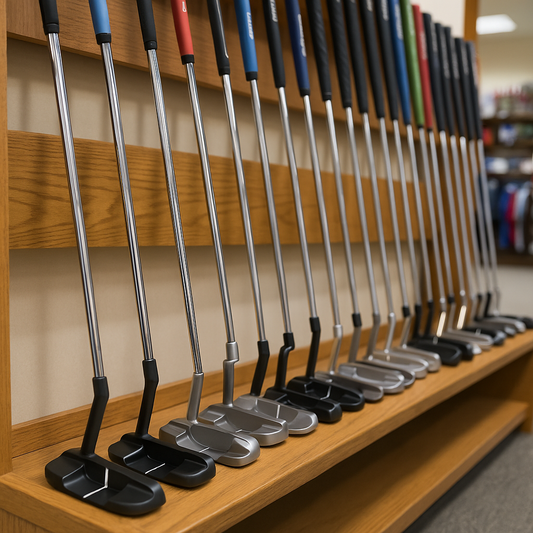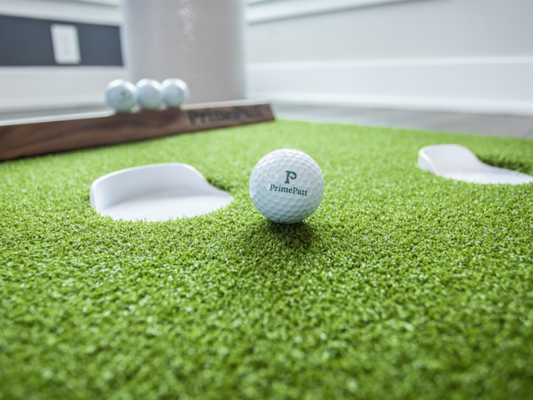After nearly three decades in the golf industry and 16 years as a PGA Professional, I've watched thousands of high-handicap golfers struggle on the greens. The truth? Most are playing with putters that work against them, not for them.
Let me be clear: there's no magic wand in golf. The "best" putter isn't universal—it's personal. But for high-handicappers specifically, certain characteristics can make an enormous difference in your confidence, consistency, and ultimately, your scorecard.
Why Your Putter Choice Matters More Than You Think
Here's something most golfers don't realize: roughly 40% of your strokes happen on the green. For a high-handicapper shooting in the 90s, that's about 36 putts per round. Cut that to 32 putts, and you've just dropped four strokes without changing anything else in your game.

I've fit countless junior players over the years, and the transformation can be immediate. Just last month, I worked with a 16-year-old competitive golfer who had been using the same hand-me-down blade putter since starting golf three years ago. After thirty minutes with a properly fitted mallet that matched his straight-back-straight-through stroke, he immediately started draining 6-8 footers with remarkable consistency.
"Coach, I feel like I'm cheating," he told me after our session. Two weeks later, he shaved three strokes off his tournament average.
Understanding What You Need (Not What Pros Use)
Before diving into specific recommendations, let's establish what high-handicappers typically struggle with on the greens:
Inconsistent strike location: High-handicappers rarely hit the sweet spot consistently, making forgiveness crucial.
Face control issues: Many struggle keeping the putter face square at impact, leading to pushes and pulls.
Distance control: Three-putts often come from poor distance judgment, not necessarily bad aim.
Confidence: Perhaps most importantly, many high-handicappers simply don't trust themselves over the ball.
With these challenges in mind, let's explore what characteristics matter most for your game, regardless of brand name or price tag.
The Mallet vs. Blade Decision: What's Right for You?
The first major decision is between a mallet or a blade putter. While there are exceptions to every rule, here's my general guidance after fitting thousands of players:
Most Forgiving Putter: When a Mallet Makes Sense
If you're a high-handicapper, a mallet putter likely offers significant advantages. The larger head provides more forgiveness on off-center hits, which is critical when you're not striking the ball consistently in the sweet spot.
Mallets distribute weight around the perimeter of the head, increasing the moment of inertia (MOI). In plain English, this means the putter twists less when you hit the ball off-center, keeping more putts on line even with imperfect contact.
I've noticed that mallets particularly benefit golfers with a straight-back-straight-through putting stroke. The face-balanced design of most mallets naturally resists opening and closing during the stroke, helping maintain a square face at impact.
Many of my high-handicap students also appreciate the alignment aids that typically come with mallet designs. The additional lines, dots, and visual cues can dramatically improve your ability to aim correctly.
Bottom Line: The mallet putter is the most forgiving putter type, best suited for new players or those struggling with their putting game.
When a Blade Might Work Better
Despite the advantages of mallets, some high-handicappers still perform better with blade putters. If you have a noticeable arc in your putting stroke (the putter naturally opens on the backstroke and closes through impact), a blade with toe hang might complement your natural motion better.
Blades also tend to provide more feedback on strike location. While this can be intimidating for some, other players find this feedback helps them develop consistency faster.
Some golfers simply prefer the clean, traditional look of a blade putter. Never underestimate the importance of confidence—if looking down at your putter gives you positive feelings, that's worth something.
Bottom Line: Blade putters offer superior feedback on strikes, making it an ideal option for more experienced putters who want more control.
Face Technology: Insert vs. Milled
Beyond head shape, the face construction significantly impacts feel and performance.
Insert Faces
Insert putters have a different material inlaid into the face—typically metal, plastic, urethane, or rubber. This design allows manufacturers to create specific feel characteristics.
For high-handicappers, insert faces can provide a softer impact sensation and more consistent roll, even on mishits. The forgiveness factor here can be significant, especially if you struggle with distance control.
Milled Faces
A milled putter is crafted from a single piece of metal with the face precisely milled by a CNC machine. This creates a consistent, uniform surface across the entire face.
While milled faces typically provide more direct feedback (you'll feel exactly where you struck the ball), newer milled designs have incorporated variable depth milling patterns that can help with off-center hits.
Finding Your Ideal Length and Lie
One of the most overlooked aspects of putter fitting is getting the correct length and lie angle. I've seen countless high-handicappers struggling with putters that are simply too long for them.
Standard putters range from 33" to 35", but finding the right length for your height and setup is essential. When properly fit, your arms should hang naturally with your eyes positioned directly over or slightly inside the ball.
The lie angle—how the putter sole sits on the ground at address—is equally important. If the toe is up in the air or digging into the ground, you're fighting physics before you even start your stroke.
Three Popular Putters Worth Considering for High-Handicappers in 2025
While I maintain that characteristics matter more than specific models, here are three putters that exemplify what most high-handicappers need:
TaylorMade Spider GT Notchback
The Spider line has been helping high-handicappers for years, and the GT Notchback continues this tradition. Its high-MOI mallet design shifts weight toward the perimeter, providing exceptional stability on off-center hits.
What makes this putter particularly effective for high-handicappers is the Pure Roll insert, which promotes forward roll and consistent distance control—even when you miss the sweet spot. The helpful alignment lines make it easier to square the face at address, addressing one of the biggest challenges for developing players.
Odyssey Ai-One Square 2 Square
This newer entry into the "zero torque" putter space is remarkably forgiving. The weighting keeps the shaft in line with the head's center of gravity, helping the face naturally remain square throughout the stroke.
The Versa technology in the head provides excellent alignment cues, while the Ai-One insert features variable face thickness that allows for more consistent roll on mishits. During testing with my students, this putter has shown particular promise for players who struggle with keeping the face square at impact.
The Ping Fetch offers high MOI and exceptional forgiveness in a unique package. What makes this putter special is how Ping has distributed weight around the perimeter while maintaining a clean look at address.
The stainless-steel body combined with an aluminum sole plate creates a responsive yet soft feel, and the built-in alignment aids help ensure you're starting the ball on your intended line. Several of my high-handicap students have found immediate success with this model.
Beyond the Brand: What Really Matters
After fitting countless golfers over the years, I've found that the following characteristics matter far more than the name on the putter:
1. Face Balance and Toe Hang
Understanding your stroke type is crucial. If you have a straight-back-straight-through stroke, a face-balanced putter will help keep the face square. If you have an arcing stroke, a putter with toe hang will complement your natural motion.
To check face balance, balance the putter shaft on your finger. If the face points up toward the sky, it's face-balanced. If the toe points downward, it has toe hang.
2. Head Weight and Feel
Some golfers prefer a heavier putter that swings like a pendulum, while others like a lighter touch. There's no right answer here—it's about what gives you confidence and consistency.
I've found that many high-handicappers benefit from a slightly heavier putter (340-360 grams) that helps steady the hands and reduce wrist action.
3. Alignment Features
Never underestimate the importance of being able to aim correctly. If you struggle with alignment, look for a putter with clear visual cues that help you square the face and aim at your target.
Some players prefer a single alignment line, while others benefit from multiple lines or the popular "2-ball" style alignment systems.
4. Grip Size
The grip size affects how your hands interact with the putter and can significantly impact your stroke.
As a general rule, a larger grip tends to quiet the hands and reduce face rotation—helpful if you tend to pull putts left (for right-handed golfers). Conversely, a smaller grip can increase face rotation, which might help if you leave putts out to the right.
The Fitting Process: How to Find Your Perfect Match
If you're serious about improving your putting, consider a professional fitting. But if that's not an option, here's my process for finding your perfect match:
1. Record your current putting stroke from face-on and down-the-line angles
2. Analyze what your putter face is doing at impact
3. Determine if you have a straight or arcing stroke
4. Try putters that match your stroke type
5. Experiment with different head weights and grip sizes
6. Focus on models that give you confidence at address
Remember, the perfect putter combines the right physical characteristics with the intangible element of confidence. When you stand over a putt with complete trust in your equipment, magic happens.
Final Thoughts
After decades in the golf industry, I've learned that putting is deeply personal. What works for one player might be completely wrong for another.
The best putter for you combines the right physical characteristics with the intangible element of confidence. When you stand over a putt with complete trust in your equipment, magic happens.
Whether you choose a mallet for forgiveness, a blade for feel, or something in between, make sure it suits your eye and your stroke. Take time to experiment with different options, and don't be afraid to go against conventional wisdom if something unconventional feels right to you.
Remember, the perfect putter isn't necessarily the most expensive or the one your favorite pro uses—it's the one that helps you hole more putts. And at the end of the day, that's all that matters.





